Vincent van Gogh
- Birth Date:
- 30.03.1853
- Death date:
- 29.07.1890
- Person's maiden name:
- Vincent Willem van Gogh
- Extra names:
- Vincent van Gogh, Vinsents van Gogs, Vinsents Vilems van Gogs; Vincent Willem van Gogh, Fransisko Hosē de Goija (Francisco José de Goya y Lucientes, Винсент ван Гог, Fransisko Hosē de Goija (Francisco José de Goya y
- Categories:
- Artist, Painter
- Nationality:
- hollander
- Cemetery:
- Cimetiere Auvers-sur-Oise
Vincent Willem van Gogh (Dutch: [ˈvɪnsɛnt ˈʋɪləɱ vɑŋ ˈɣɔχ] ; 30 March 1853 – 29 July 1890) was a Dutch post-Impressionist painter whose work, notable for its rough beauty, emotional honesty and bold color, had a far-reaching influence on 20th-century art.
After years of painful anxiety and frequent bouts of mental illness, he died aged 37 from a gunshot wound, generally accepted to be self-inflicted (although no gun was ever found). His work was then known to only a handful of people and appreciated by fewer still.
Van Gogh began to draw as a child, and he continued to draw throughout the years that led up to his decision to become an artist. He did not begin painting until his late twenties, completing many of his best-known works during the last two years of his life. In just over a decade, he produced more than 2,100 artworks, consisting of 860 oil paintings and more than 1,300 watercolors, drawings, sketches and prints. His work included self portraits, landscapes, still lifes, portraits and paintings of cypresses, wheat fields and sunflowers.
Van Gogh spent his early adulthood working for a firm of art dealers, traveling between The Hague, London and Paris, after which he taught for a time in England.
One of his early aspirations was to become a pastor and from 1879 he worked as a missionary in a mining region in Belgium where he began to sketch people from the local community.
In 1885, he painted his first major work The Potato Eaters. His palette at the time consisted mainly of somber earth tones and showed no sign of the vivid coloration that distinguished his later work. In March 1886, he moved to Paris and discovered the French Impressionists. Later, he moved to the south of France and was influenced by the strong sunlight he found there. His work grew brighter in color, and he developed the unique and highly recognizable style that became fully realized during his stay in Arles in 1888.
The extent to which his mental health affected his painting has been a subject of speculation since his death. Despite a widespread tendency to romanticize his ill health, modern critics see an artist deeply frustrated by the inactivity and incoherence brought about by his bouts of illness. According to art critic Robert Hughes, Van Gogh's late works show an artist at the height of his ability, completely in control and "longing for concision and grace".
Letters
The most comprehensive primary source for the understanding of Van Gogh as an artist is the collection of letters between him and his younger brother, art dealer Theo van Gogh. They lay the foundation for most of what is known about the thoughts and beliefs of the artist. Theo provided his brother with both financial and emotional support. Their lifelong friendship, and most of what is known of Van Gogh's thoughts and theories of art, is recorded in the hundreds of letters they exchanged between 1872 and 1890: more than 600 from Vincent to Theo and 40 from Theo to Vincent.
Although many are undated, art historians have generally been able to put them in chronological order. Problems remain, mainly in dating those from Arles, although it is known that during that period, Van Gogh wrote 200 letters to friends in Dutch, French and English. The period when Vincent lived in Paris is the most difficult for historians to analyze because the brothers lived together and had no need to correspond.
In addition to letters to and from Theo, other surviving documents include those to Van Rappard, Émile Bernard, Van Gogh's sister Wil and her friend Line Kruysse. The letters were first annotated in 1913 by Theo's widow Johanna van Gogh-Bonger who explained that she published them with 'trepidation' because she did not want the drama in the artist's life to overshadow his work. Van Gogh himself was an avid reader of other artists' biographies and expected their lives to be in keeping with the character of their art.
Biography
Early life
Vincent Willem van Gogh was born on 30 March 1853 in Groot-Zundert, a village close to Breda in the province of North Brabant in the south of the Netherlands, a predominantly Catholic area. He was the oldest child of Theodorus van Gogh, a minister of the Dutch Reformed Church, and Anna Cornelia Carbentus. Vincent was given the name of his grandfather, and of a brother stillborn exactly a year before his birth. The practice of reusing a name was not unusual. Vincent was a common name in the Van Gogh family: his grandfather, Vincent (1789–1874), had received his degree of theology at the University of Leiden in 1811. Grandfather Vincent had six sons, three of whom became art dealers, including another Vincent who was referred to in Van Gogh's letters as "Uncle Cent". Grandfather Vincent had perhaps been named in turn after his own father's uncle, the successful sculptor Vincent van Gogh (1729–1802).Art and religion were the two occupations to which the Van Gogh family gravitated. His brother Theodorus "Theo" was born on 1 May 1857. He had another brother, Cor, and three sisters: Elisabeth, Anna and Willemina "Wil".
As a child, Vincent was serious, silent and thoughtful. He attended the Zundert village school from 1860, where the single Catholic teacher taught around 200 pupils.
From 1861, he and his sister Anna were taught at home by a governess, until 1 October 1864, when he went to Jan Provily's boarding school at Zevenbergen about 20 miles (32 km) away. He was distressed to leave his family home as he recalled later as an adult. On 15 September 1866, he went to the new middle school, Willem II College in Tilburg. Constantijn C. Huysmans, a successful artist in Paris, taught Van Gogh to draw at the school and advocated a systematic approach to the subject. Vincent's interest in art began at an early age. He began to draw as a child and continued making drawings throughout the years leading to his decision to become an artist. Though well-done and expressive, his early drawings do not approach the intensity he developed in his later work.
In March 1868, Van Gogh abruptly left school and returned home. A later comment on his early years was in an 1883 letter to Theo in which he wrote, "My youth was gloomy and cold and sterile".
In July 1869, his uncle Cent helped him obtain a position with the art dealer Goupil & Cie in The Hague. After his training, in June 1873, Goupil transferred him to London, where he lodged at 87 Hackford Road, Brixton, and worked at Messrs. Goupil & Co., 17 Southampton Street. This was a happy time for Vincent; he was successful at work and was, at 20, earning more than his father. Theo's wife later remarked that this was the happiest year of Vincent's life. He fell in love with his landlady's daughter, Eugénie Loyer, but when he finally confessed his feelings to her, she rejected him, saying that she was secretly engaged to a former lodger. He became increasingly isolated and fervent about religion; his father and uncle arranged for him to be transferred to Paris, where he became resentful at how art was treated as a commodity, a fact apparent to customers. On 1 April 1876, Goupil terminated his employment.
Van Gogh returned to England for unpaid work as a supply teacher in a small boarding school overlooking the harbor in Ramsgate, where he made sketches of the view. When the proprietor of the school relocated to Isleworth, Middlesex, Van Gogh moved with him, taking the train to Richmond and the remainder of the journey on foot. The arrangement did not work out and he left to become a Methodist minister's assistant, following his wish to "preach the gospel everywhere." At Christmas, he returned home and found work in a bookshop in Dordrecht for six months. He was not happy in this new position and spent much of his time either doodling or translating passages from the Bible into English, French and German. His roommate at the time, a young teacher named Görlitz, recalled that Van Gogh ate frugally, and preferred not to eat meat.
Van Gogh's religious zeal grew until he felt he had found his true vocation. To support his effort to become a pastor, his family sent him to Amsterdam to study theology in May 1877, where he stayed with his uncle Jan van Gogh, a naval Vice Admiral. Vincent prepared for the entrance exam with his uncle Johannes Stricker; a respected theologian who published the first "Life of Jesus" in the Netherlands. Van Gogh failed the exam, and left his uncle Jan's house in July 1878. He then undertook, but failed, a three-month course at the Vlaamsche Opleidingsschool, a Protestant missionary school in Laeken, near Brussels.


The house where Van Gogh stayed in Cuesmes in 1880; while living here he decided to become an artist
In January 1879, he took a temporary post as a missionary in the village of Petit Wasmes in the coal-mining district of Borinage in Belgium. Taking Christianity to what he saw as its logical conclusion, Van Gogh lived like those he preached to, sleeping on straw in a small hut at the back of the baker's house where he was staying. The baker's wife reported hearing Van Gogh sobbing at night in the hut. His choice of squalid living conditions did not endear him to the appalled church authorities, who dismissed him for "undermining the dignity of the priesthood." He then walked to Brussels, returned briefly to the village of Cuesmes in the Borinage, but gave in to pressure from his parents to return home to Etten. He stayed there until around March the following year, a cause of increasing concern and frustration for his parents. There was particular conflict between Vincent and his father; Theodorus made inquiries about having his son committed to the lunatic asylum at Geel.
He returned to Cuesmes where he lodged until October with a miner named Charles Decrucq. Increasingly interested in the people and scenes around him, Van Gogh recorded his time there in his drawings and followed Theo's suggestion that he should take up art in earnest. He traveled to Brussels that autumn intending to follow Theo's recommendation to study with the prominent Dutch artist Willem Roelofs, who persuaded him, in spite of his aversion to formal schools of art, to attend the Académie Royale des Beaux-Arts in Brussels, where he registered on 15 November 1880. At the Académie, he studied anatomy and the standard rules of modeling and perspective, about which he said, "...you have to know just to be able to draw the least thing." Van Gogh aspired to become an artist in God's service, stating: "...to try to understand the real significance of what the great artists, the serious masters, tell us in their masterpieces, that leads to God; one man wrote or told it in a book; another in a picture."
Etten, Drenthe and The Hague


Annotated by the artist in ink at lower left: At Eternity's Gate, 1882, lithograph, Tehran Museum of Contemporary Art


Kee Vos Stricker with her son Jan c. 1879/1880.
In April 1881, Van Gogh moved to the Etten countryside with his parents where he continued drawing, often using neighbors as subjects. Through the summer he spent time walking and talking with his recently widowed cousin, Kee Vos-Stricker, the daughter of his mother's older sister and Johannes Stricker, with whom he stayed in Amsterdam in 1878. Kee, who had an eight-year-old son, was seven years older than Van Gogh. He proposed marriage, but she refused with the words, "No, nay, never," ("nooit, neen, nimmer"). Late that November, Van Gogh wrote a strongly worded letter to Johannes, and then hurried to Amsterdam where he spoke with him on several occasions. Kee refused to see him, and her parents wrote, "Your persistence is disgusting." In desperation, he held his left hand in the flame of a lamp, with the words "Let me see her for as long as I can keep my hand in the flame." He did not recall the event well, but later assumed that his uncle blew out the flame. Kee's father made it clear to him that Kee's refusal should be heeded and that the two would not be married because of Van Gogh's inability to support himself. Van Gogh's perception of his uncle and former tutor's hypocrisy affected him deeply and put an end to his religious faith forever. That Christmas he refused to go to church, quarreling violently with his father as a result and leading him to leave home the same day for The Hague.


Rooftops, View from the Atelier The Hague, 1882, watercolour, Private collection.
In January 1882, he settled in The Hague where he called on his cousin-in-law, Anton Mauve (1838–88), who was a Dutch realist painter and a leading member of the Hague School. Mauve introduced him to painting in both oil and watercolor and lent him money to set up a studio but the two soon fell out, possibly over the issue of drawing from plaster casts. Mauve appears to have suddenly gone cold towards Van Gogh and did not return a number of his letters. Van Gogh supposed that he had learned of his new domestic arrangement with an alcoholic prostitute, Clasina Maria "Sien" Hoornik (1850–1904), and her young daughter. He had met Sien towards the end of January when she had a five-year-old daughter and was pregnant. She had already borne two children who had died, although Van Gogh was unaware of this. On 2 July, she gave birth to a baby boy, Willem. When Van Gogh's father discovered the details of their relationship, he put considerable pressure on his son to abandon Sien and her children, although Vincent at first defied him.
Van Gogh's uncle Cornelis, an art dealer, commissioned 12 ink drawings of views of the city, which Van Gogh completed soon after arriving in The Hague, along with a further seven drawings that May. In June, he spent three weeks in a hospital suffering from gonorrhea. During the summer he began to paint in oil. In autumn 1883, after a year together, he left Sien and the two children. He had thought of moving the family out of the city but in the end made the break. It is possible that lack of money pushed Sien back to prostitution; the home became less happy, and Van Gogh may have felt family life was irreconcilable with his artistic development. When he left, Sien gave her daughter to her mother and baby Willem to her brother. She then moved to Delft, and later to Antwerp. Willem remembered being taken to visit his mother in Rotterdam at around the age of 12, where his uncle tried to persuade Sien to marry in order to legitimize the child. Willem remembered his mother saying, "But I know who the father is. He was an artist I lived with nearly 20 years ago in The Hague. His name was Van Gogh." She then turned to Willem and said "You are called after him." While Willem believed himself Van Gogh's son, the timing of his birth makes this unlikely. In 1904, Sien drowned herself in the River Scheldt. Van Gogh moved to the Dutch province of Drenthe, in the northern Netherlands. That December, driven by loneliness, he went to stay with his parents who had been posted to Nuenen, North Brabant.
Emerging artist Nuenen and Antwerp (1883–1886)
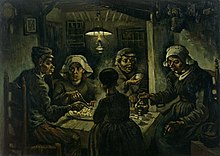

The Potato Eaters, 1885, Van Gogh Museum
In Nuenen, Van Gogh devoted himself to drawing, and he gave money to boys to bring him birds' nests for subject matter for paintings, and he made many sketches and paintings of weavers in their cottages. In autumn 1884, Margot Begemann, a neighbor's daughter and ten years his senior, often joined him on his painting forays. She fell in love, and he reciprocated—though less enthusiastically. They decided to marry, but the idea was opposed by both families. As a result, Margot took an overdose of strychnine. She was saved when Van Gogh rushed her to a nearby hospital. On 26 March 1885, his father died of a heart attack and he grieved deeply at the loss.


Skull of a Skeleton with Burning Cigarette, 1885–1886, oil on canvas, Van Gogh Museum
For the first time, there was interest from Paris in his work. That spring, he completed what is generally considered his first major work, The Potato Eaters, the culmination of several years work painting peasant character studies. In August 1885, his work was exhibited for the first time, in the windows of a paint dealer, Leurs, in The Hague. When he was accused of forcing himself on one of his young peasant sitters Gordina de Groot who became pregnant that September the Catholic village priest forbade parishioners from modeling for him. During 1885, he painted several groups of still-life paintings.
From this period, Still-Life with Straw Hat and Pipe and Still-life with Earthen Pot and Clogs are characterized by smooth, meticulous brushwork and fine shading of colors. During his two-year stay in Nuenen, he completed numerous drawings and watercolors and nearly 200 oil paintings. His palette consisted mainly of somber earth tones, particularly dark brown, and he showed no sign of developing the vivid coloration that distinguishes his later, best-known work. When he complained that Theo was not making enough effort to sell his paintings in Paris, his brother wrote back, telling him that the paintings were too dark and not in line with the current style of bright Impressionist paintings.
In November 1885, he moved to Antwerp and rented a small room above a paint dealer's shop in the Rue des Images (Lange Beeldekensstraat). He had little money and ate poorly, preferring to spend the money Theo sent on painting materials and models. Bread, coffee and tobacco were his staple intake. In February 1886, he wrote to Theo saying that he could only remember eating six hot meals since May of the previous year. His teeth became loose and painful. While in Antwerp he applied himself to the study of color theory and spent time in museums, particularly studying the work of Peter Paul Rubens, gaining encouragement to broaden his palette to carmine, cobalt and emerald green. He bought a number of Japanese Ukiyo-e woodcuts in the docklands, and incorporated their style into the background of a number of his paintings. While in Antwerp, Van Gogh began to drink absinthe heavily. He was treated by Dr. Amadeus Cavenaile, whose practice was near the docklands, possibly for syphilis; the treatment of alum irrigation and sitz baths was jotted down by Van Gogh in one of his notebooks. Despite his rejection of academic teaching, he took the higher-level admission exams at the Academy of Fine Arts in Antwerp, and in January 1886, matriculated in painting and drawing. For most of February, he was ill and run down by overwork, a poor diet and excessive smoking.
Paris (1886–1888)
 Courtesan (after Eisen), 1887, Van Gogh Museum
Courtesan (after Eisen), 1887, Van Gogh Museum
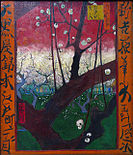 The Blooming Plumtree (after Hiroshige), 1887, Van Gogh Museum
The Blooming Plumtree (after Hiroshige), 1887, Van Gogh Museum
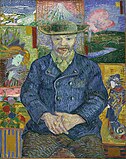
Van Gogh traveled to Paris in March 1886, where he shared Theo's Rue Laval apartment on Montmartre, to study at Fernand Cormon's studio. In June, they took a larger apartment further uphill, at 54 Rue Lepic. Because they had no need to write letters to communicate, little is known about this stay in Paris. In Paris he painted portraits of friends and acquaintances, still-life paintings, views of Le Moulin de la Galette, scenes in Montmartre, Asnières, and along the Seine.
During his stay in Paris, he collected more Japanese ukiyo-e woodblock prints; he became interested in such works, when in 1885 in Antwerp he used them to decorate the walls of his studio. He collected hundreds of prints, which are visible in the backgrounds of several of his paintings. In his 1887 Portrait of Père Tanguy several can be seen hanging on the wall behind the main figure. In The Courtesan or Oiran (after Kesai Eisen) (1887), Van Gogh traced the figure from a reproduction on the cover of the magazine Paris Illustre, which he then graphically enlarged in the painting. His 1888 Plum Tree in Blossom (After Hiroshige) is a vivid example of the admiration he had for the prints he collected. His version is slightly bolder than Hiroshige's original.
After seeing Adolphe Joseph Thomas Monticelli's work at the Galerie Delareybarette, which he admired, Van Gogh immediately adopted a brighter palette and a bolder attack, particularly in paintings such as his Seascape at Saintes-Maries (1888). Two years later, in 1890, Vincent and Theo paid to have a book about Monticelli published, and Van Gogh bought a number of Monticelli's paintings, adding them to his collection.


Henri de Toulouse-Lautrec, Portrait of Vincent van Gogh, 1887, pastel drawing, Van Gogh Museum.
For months, Van Gogh worked at Cormon's studio where he frequented the circle of the British-Australian artist John Peter Russell, and met fellow students like Émile Bernard, Louis Anquetin, and Henri de Toulouse-Lautrec—who painted a portrait of Van Gogh with pastel. The group congregated at Julien "Père" Tanguy's paint store; at that time the only place where Paul Cézanne's paintings were displayed. He had easy access to Impressionist works in Paris at the time. In 1886, two large vanguard exhibitions were staged; shows where Neo-Impressionism was first exhibited and seen, with works by Georges Seurat and Paul Signac becoming the talk of the town. Though Theo kept a stock of Impressionist paintings in his gallery on Boulevard Montmarte—by artists including Claude Monet, Alfred Sisley, Edgar Degas and Camille Pissarro—Van Gogh seemingly had problems acknowledging developments in how artists view and paint their subject matter.
Conflicts arose between the brothers. At the end of 1886 Theo found that living with Vincent was "almost unbearable". By the spring of 1887, they were again at peace, although Van Gogh moved to Asnières a northwestern suburb of Paris, where he became acquainted with Signac. With Émile Bernard he adopted elements of pointillism, a technique in which a multitude of small colored dots are applied to the canvas that, when seen from a distance, create an optical blend of hues. The style stresses the value of complementary colors—including blue and orange—to form vibrant contrasts that are enhanced when juxtaposed. While in Asnières he painted parks and restaurants and the Seine, including Bridges across the Seine at Asnieres.
In November 1887, Theo and Vincent met and befriended Paul Gauguin who had just arrived in Paris. Towards the end of the year, Vincent arranged an exhibition of paintings by himself, Bernard, Anquetin, and probably Toulouse-Lautrec in the Grand-Bouillon Restaurant du Chalet, 43 Avenue de Clichy, in Montmartre. In a contemporary account, Emile Bernard wrote of the event: "On the avenue de Clichy a new restaurant was opened. Vincent used to eat there. He proposed to the manager that an exhibition be held there .... Canvases by Anquetin, by Lautrec, by Koning ...filled the hall....It really had the impact of something new; it was more modern than anything that was made in Paris at that moment." There Bernard and Anquetin sold their first paintings, and Van Gogh exchanged work with Gauguin who soon departed to Pont-Aven. Discussions on art, artists and their social situations that started during this exhibition continued and expanded to include visitors to the show like Pissarro and his son Lucien, Signac and Seurat. Finally in February 1888, feeling worn out from life in Paris, he left, having painted over 200 paintings during his two years in the city. Only hours before his departure, accompanied by Theo, he paid his first and only visit to Seurat in his atelier (studio).
Artistic breakthrough and final years Move to Arles (1888–1889)
 The Yellow House, 1888, Van Gogh Museum
The Yellow House, 1888, Van Gogh Museum
 Bedroom in Arles, 1888, Van Gogh Museum
Bedroom in Arles, 1888, Van Gogh Museum
Van Gogh moved to Arles hoping for refuge at a time when he was ill from drink and suffering from smoker's cough. He arrived on 21 February 1888, and took a room at the Hôtel-Restaurant Carrel, which, idealistically, he had expected to look like one of Hokusai (1760–1849) or Utamaro's (1753–1806) prints. He seems to have had moved to the town with thoughts of founding a utopian art colony. The Danish artist Christian Mourier-Petersen (1858–1945), became his companion for two months, and at first Arles appeared exotic and filthy. In a letter he described it as a foreign country: "The Zouaves, the brothels, the adorable little Arlesiennes going to their First Communion, the priest in his surplice, who looks like a dangerous rhinocerous, the people drinking absinthe, all seem to me creatures from another world". A hundred years later, Van Gogh was remembered by 113-year-old Jeanne Calment—who, as a 13 year old, was serving in her uncle's fabric shop where Van Gogh wanted to buy some canvas—as "dirty, badly dressed and disagreeable", and "very ugly, ungracious, impolite, sick". She also recalled selling him colored pencils.
Van Gogh was enchanted by the local landscape and light, and his works from the period are richly draped in yellow, ultramarine and mauve. His portrayals of the Arles landscape are informed by his Dutch upbringing; the patchwork of fields and avenues appear flat and lack perspective, but excel in their intensity of color. The vibrant light in Arles excited him, and his newfound appreciation is seen in the range and scope of his work. That March he painted local landscapes using a gridded "perspective frame". Three of these paintings were shown at the annual exhibition of the Société des Artistes Indépendants. In April, he was visited by the American artist Dodge MacKnight, who was living nearby at Fontvieille. On 1 May, he signed a lease for 15 francs a month in the eastern wing of the Yellow House at No. 2 Place Lamartine. The rooms were unfurnished and uninhabited for some time. He was still at the Hôtel Restaurant Carrel, but the rate charged by the hotel was 5 francs a week, which he found excessive. He disputed the price, took the case to a local arbitrator and was awarded a twelve franc reduction on the total bill.
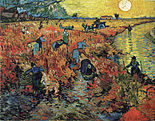 The Red Vineyard, November 1888, Pushkin Museum, Moscow). Sold to Anna Boch, 1890
The Red Vineyard, November 1888, Pushkin Museum, Moscow). Sold to Anna Boch, 1890
 The Night Café, 1888, Yale University Art Gallery, New Haven
The Night Café, 1888, Yale University Art Gallery, New Haven
 Paul Gauguin's Armchair, 1888, Van Gogh Museum
Paul Gauguin's Armchair, 1888, Van Gogh Museum
He moved from the Hôtel Carrel to the Café de la Gare on 7 May, where he became friends with the proprietors, Joseph and Marie Ginoux. Although the Yellow House had to be furnished before he could fully move in, Van Gogh was able to utilize it as a studio. Hoping to have a gallery to display his work, his project at this time was a series of paintings including Van Gogh's Chair (1888), Bedroom in Arles (1888), The Night Café (1888), Cafe Terrace at Night (September 1888), Starry Night Over the Rhone (1888), Still Life: Vase with Twelve Sunflowers (1888), all intended to form the décoration for the Yellow House. Van Gogh wrote about The Night Café: "I have tried to express the idea that the café is a place where one can ruin oneself, go mad, or commit a crime."
When he visited Saintes-Maries-de-la-Mer that June he gave drawing lessons to a Zouave second lieutenant, Paul-Eugène Milliet and painted boats on the sea and the village. MacKnight introduced Van Gogh to Eugène Boch, a Belgian painter who stayed at times in Fontvieille, and the two exchanged visits in July.
Gauguin's visit
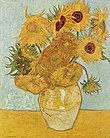 Still Life: Vase with Twelve Sunflowers, August 1888, Neue Pinakothek, Munich
Still Life: Vase with Twelve Sunflowers, August 1888, Neue Pinakothek, Munich
 The Café Terrace on the Place du Forum, Arles, at Night, September 1888, Kröller-Müller Museum, Otterlo, The Netherlands
The Café Terrace on the Place du Forum, Arles, at Night, September 1888, Kröller-Müller Museum, Otterlo, The Netherlands
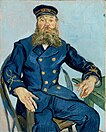 Joseph Roulin (The Postman), 1888, Museum of Fine Arts, Boston
Joseph Roulin (The Postman), 1888, Museum of Fine Arts, Boston
 Van Gogh's Chair, 1888, National Gallery, London
Van Gogh's Chair, 1888, National Gallery, London
When Gauguin agreed to visit Arles, Van Gogh hoped for friendship and for his utopian idea of a collective of artists. In anticipation that August he painted sunflowers. When Boch visited again, Van Gogh painted a portrait of him, as well as the study The Poet Against a Starry Sky. Boch's sister Anna (1848–1936), also an artist, purchased The Red Vineyard in 1890. In preparation for Gauguin's visit he bought two beds, on advice from his friend the station's postal supervisor Joseph Roulin, whose portrait he painted, and on 17 September spent the first night in the still sparsely furnished Yellow House. When Gauguin consented to work and live side-by-side in Arles with Van Gogh, he started to work on The Décoration for the Yellow House, probably the most ambitious effort he ever undertook. Van Gogh did two chair paintings: Van Gogh's Chair and Gauguin's Chair.
After repeated requests, Gauguin finally arrived in Arles on 23 October. During November, the two painted together. Gauguin painted Van Gogh's portrait The Painter of Sunflowers: Portrait of Vincent van Gogh, and uncharacteristically, Van Gogh painted some pictures from memory—deferring to Gauguin's ideas in this—as well as his The Red Vineyard. Their first joint outdoor painting exercise produced Les Alyscamps, and was conducted at the Alyscamps.
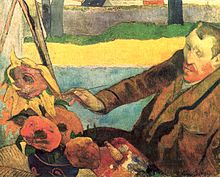

Paul Gauguin, The Painter of Sunflowers: Portrait of Vincent van Gogh, 1888, Van Gogh Museum, Amsterdam.
The two visited Montpellier that December and viewed works in the Alfred Bruyas collection by Courbet and Delacroix in the Musée Fabre,but their relationship began to deteriorate. Van Gogh greatly admired Gauguin, and desperately wanted to be treated as his equal. But Gauguin was arrogant and domineering, a fact that often frustrated Van Gogh. They quarreled fiercely about art; Van Gogh felt an increasing fear that Gauguin was going to desert him, as a situation he described as one of "excessive tension" reached crisis point.
On 23 December 1888, frustrated and ill, Van Gogh confronted Gauguin with a razor blade, but in panic, left and fled to a local brothel. Deeply lonely at the time, he often visited the prostitutes at a brothel on Rue du Bout d'Aeles as his single emotional and sensuous point of contact with other people. While there, he cut off his left ear, though it is often claimed that it was only the lower part of his left earlobe. He wrapped the severed ear in newspaper and handed it to a prostitute named Rachel, asking her to "keep this object carefully." He staggered home, where he was later found by Gauguin lying unconscious with his head covered in blood.
Van Gogh was taken to a hospital and remained in a critical state for several days. He asked for Gauguin continually over the next number of days, but the Frenchman stayed away. Gauguin told one of the policeman attending the case, "Be kind enough, Monsieur, to awaken this man with great care, and if he asks for me tell him I have left for Paris; the sight of me might prove fatal for him." Gauguin wrote of Van Gogh, "His state is worse, he wants to sleep with the patients, chase the nurses, and washes himself in the coal bucket. That is to say, he continues the biblical mortifications." Theo—notified by Gauguin—visited, as did both Madame Ginoux and Roulin. Gauguin left Arles and never saw Van Gogh again. In January 1889, Van Gogh returned to the Yellow House, but spent the following month between the hospital and home, suffering from hallucinations and delusions that he was being poisoned. In March, the police closed his house after a petition by 30 townspeople, who called him "fou roux" (the redheaded madman). Paul Signac visited him in the hospital and Van Gogh was allowed home in his company. In April, he moved into rooms owned by Dr. Rey, after floods damaged paintings in his own home. Around this time, he wrote, "Sometimes moods of indescribable anguish, sometimes moments when the veil of time and fatality of circumstances seemed to be torn apart for an instant." Two months later he had left Arles and entered an asylum in Saint-Rémy-de-Provence.
Saint-Rémy (May 1889 – May 1890)
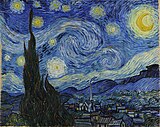 The Starry Night, June 1889, The Museum of Modern Art, New York
The Starry Night, June 1889, The Museum of Modern Art, New York
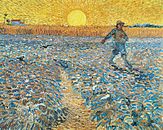 The Sower, 1888, Kröller-Müller Museum
The Sower, 1888, Kröller-Müller Museum
On 8 May 1889, accompanied by his carer, the Reverend Salles, Van Gogh committed himself to the hospital at Saint Paul-de-Mausole. A former monastery in Saint-Rémy less than 20 miles (32 km) from Arles, the monastery is located in an area of cornfields, vineyards and olive trees at the time run by a former naval doctor, Dr. Théophile Peyron. Theo arranged for two small rooms—adjoining cells with barred windows. The second was to be used as a studio.
During his stay, the clinic and its garden became the main subjects of his paintings. He made several studies of the hospital interiors, such as Vestibule of the Asylum and Saint-Remy (September 1889). Some of the work from this time is characterized by swirls—including one of his best-known paintings The Starry Night. He was allowed short supervised walks, which led to paintings of cypresses and olive trees, like Olive Trees with the Alpilles in the Background 1889, Cypresses 1889, Cornfield with Cypresses (1889), Country road in Provence by Night (1890). That September he also produced a further two versions of Bedroom in Arles.
Limited access to the world outside the clinic resulted in a shortage of subject matter. He was left to work on interpretations of other artist's paintings, such as Millet’s The Sower and Noon – Rest from Work (after Millet), as well as variations on his own earlier work. Van Gogh was an admirer of the Realism of Jules Breton, Gustave Courbet and Millet and compared his copies to a musician's interpreting Beethoven. Many of his most compelling works date from this period. His The Round of the Prisoners (1890) was painted after an engraving by Gustave Doré (1832–1883). It is suggested that the face of the prisoner in the center of the painting and looking toward the viewer is Van Gogh himself, although the noted Van Gogh scholar Jan Hulsker discounts this.
Towards the end of his stay, Van Gogh suffered a severe relapse lasting two month between February and April 1890. Nevertheless he was able to paint and draw a little during this time and he later wrote Theo that he had made a few small canvases "from memory ... reminisces of the North". Amongst these was Two Peasant Women Digging in a Snow-Covered Field at Sunset. Hulsker believes that this small group of paintings formed the nucleus of a large number of drawings and study sheets depicting landscapes and figures that Van Gogh worked on during this time. He comments that, save for this short period, Van Gogh's illness had hardly any effect on his work but in these he sees a reflection of Van Gogh's mental health at the time. Also belonging to this period is Sorrowing Old Man ('At Eternity's Gate'), a color study that Hulsker describes as "another unmistakable remembrance of times long past".
 The Round of the Prisoners, 1890, Pushkin Museum, Moscow
The Round of the Prisoners, 1890, Pushkin Museum, Moscow
 Two Peasant Women Digging in a Snow-Covered Field at Sunset, 1890, Foundation E.G. Bührle Collection, Zurich, Switzerland
Two Peasant Women Digging in a Snow-Covered Field at Sunset, 1890, Foundation E.G. Bührle Collection, Zurich, Switzerland
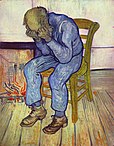 Sorrowing Old Man ('At Eternity's Gate'), 1890, Kröller-Müller Museum, Otterlo
Sorrowing Old Man ('At Eternity's Gate'), 1890, Kröller-Müller Museum, Otterlo
In February 1890 he painted five versions of L'Arlésienne (Madame Ginoux), based on a charcoal sketch Gauguin had produced when Madame Ginoux sat for both artists at the beginning of November 1888. The version intended for Madame Ginoux is lost. It was attempting to deliver this painting to Madame Ginoux in Arles that precipitated his February relapse.
His work was praised by Albert Aurier in the Mercure de France in January 1890, when he was described as "a genius". That February he was invited by Les XX, a society of avant-garde painters in Brussels, to participate in their annual exhibition. At the opening dinner, Les XX member Henry de Groux insulted Van Gogh's work. Toulouse-Lautrec demanded satisfaction, while Signac declared he would continue to fight for Van Gogh's honor if Lautrec should surrender. Later, while Van Gogh's exhibit was on display with the Artistes Indépendants in Paris, Monet said that his work was the best in the show. In February 1890, following the birth of his nephew Vincent Willem, he wrote in a letter to his mother, that with the new addition to the family, he "started right away to make a picture for him, to hang in their bedroom, branches of white almond blossom against a blue sky."
Auvers-sur-Oise (May–July 1890)


Daubigny's Garden, July 1890, Auvers, Kunstmuseum Basel, one of Van Gogh's late works
In May 1890, Van Gogh left the clinic in Saint-Rémy to move nearer the physician Dr. Paul Gachet in Auvers-sur-Oise, and also to Theo. Gachet was recommended by Camille Pissarro, had treated several other artists, and was himself an amateur artist. Van Gogh's first impression was that Gachet was "...sicker than I am, I think, or shall we say just as much." In June 1890 he painted a number of portraits of the physician, including Portrait of Dr. Gachet, and his only etching; in each the emphasis is on Gachet's melancholic disposition. Van Gogh stayed at the Auberge Ravoux, where he paid 3 francs and 50 centimes to rent an attic room measuring 75 square feet (7.0 m2).
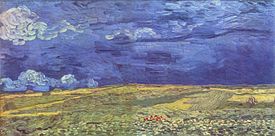 Wheatfield Under Clouded Sky, July 1890, Van Gogh Museum, Amsterdam, (F778), painted in July 1890 during his last weeks.
Wheatfield Under Clouded Sky, July 1890, Van Gogh Museum, Amsterdam, (F778), painted in July 1890 during his last weeks.
 The Church at Auvers, 1890, Musée d'Orsay, Paris
The Church at Auvers, 1890, Musée d'Orsay, Paris
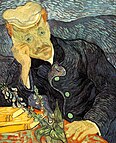 Portrait of Dr. Gachet, 1890, was sold for US$ 82.5 million in 1990. Private collection
Portrait of Dr. Gachet, 1890, was sold for US$ 82.5 million in 1990. Private collection
Before he left, In his last weeks at Saint-Rémy, Van Gogh's thoughts returned to his "memories of the North", and several of the approximately 70 oils he painted during his 70 days in Auvers-sur-Oise, such as The Church at Auvers, are reminiscent of northern scenes.
Wheat Field with Crows (July 1890) is an example of the double square technique he developed in the last weeks of his life. In its turbulent intensity, it is among his most haunting and elemental works. It is often mistakenly believed to be his last work, Hulsker lists seven paintings that postdate it.
Barbizon painter Charles Daubigny had moved to Auvers in 1861, and this in turn drew other artists there, including Camille Corot and Honoré Daumier. In July 1890, Van Gogh completed two paintings of Daubigny's Garden; one of these is likely to be his final work. There are also paintings that show evidence of being unfinished, including Thatched Cottages by a Hill.
Death
 Self-portrait, 1889, Courtauld Institute Galleries, London. Mirror-image self portrait with bandaged ear
Self-portrait, 1889, Courtauld Institute Galleries, London. Mirror-image self portrait with bandaged ear
 Still Life with Absinthe, 1887, Van Gogh Museum
Still Life with Absinthe, 1887, Van Gogh Museum
On 22 February 1890, Van Gogh suffered a new crisis that was "the starting point for one of the saddest episodes in a life already rife with sad events". This period lasted until the end of April, during which time he was unable to bring himself to write though he did continue to draw and paint. Hughes writes that from May 1889 to May 1890 he, "had fits of despair and hallucination during which he could not work, and in between them, long clear months in which he could and did, punctuated by extreme visionary ecstasy."
On 27 July 1890, aged 37, Van Gogh is believed to have shot himself in the chest with a revolver (although no gun was ever found). There were no witnesses; where he was when he shot himself is unclear. Ingo Walther writes that "Some think Van Gogh shot himself in the wheat field that had engaged his attention as an artist of late; others think he did it at a barn near the inn." Biographer David Sweetman writes that the bullet was deflected by a rib bone and passed through his chest without doing apparent damage to internal organs, probably stopped by his spine. He was able to walk back to the Auberge Ravoux. He was attended by two physicians, neither with the capability to perform surgery to remove the bullet, who left him alone in his room, smoking his pipe. The following morning (Monday), as soon as he was notified, Theo rushed to be with Vincent, to find him in surprisingly good shape; within hours, however, he began to fail, the result of untreated infection in the wound. Vincent died in the evening, 29 hours after he apparently shot himself. Theo reported his brother's last words as "The sadness will last forever."


Vincent and Theo buried together in Auvers-sur-Oise. Vincent's stone bears the inscription: Ici Repose Vincent van Gogh (1853–1890), Theo's Ici Repose Theodore van Gogh (1857–1891)
Van Gogh was buried on 30 July in the municipal cemetery of Auvers-sur-Oise at a funeral attended by Theo van Gogh, Andries Bonger, Charles Laval, Lucien Pissarro, Émile Bernard, Julien Tanguy and Dr. Gachet amongst some 20 family and friends, as well as a number of locals. The funeral was described by Émile Bernard in a letter to Albert Aurier. Theo suffered from syphilis and his health declined rapidly after Vincent's death. Weak and unable to come to terms with Vincent's absence, he died six months later, on 25 January, at Den Dolder. The original burial plot was leased for 15 years; the intention was to bury Vincent alongside Theo. Vincent's remains were exhumed on 13 June 1905, in the presence of Jo Bonger, Dr. Gachet and others, and relocated, eventually for Theo to be buried beside him. The precise location of the original grave is no longer known. In 1914, the year she had Van Gogh's letters published, Jo Bonger had Theo moved from Utrecht and reburied with Vincent.
While many of Vincent's late paintings are somber, they are essentially optimistic and reflect his desire to return to lucid mental health right up to the time of his death. Yet some of his final works reflect his deepening concerns. Referring to his paintings of wheatfields under troubled skies, he commented in a letter to his brother Theo: "I did not have to go out of my way very much in order to try to express sadness and extreme loneliness." Nevertheless, he adds in the same paragraph: " ... these canvases will tell you what I cannot say in words, that is, how healthy and invigorating I find the countryside".
There has been much debate over the years as to the source of Van Gogh's illness and its effect on his work. Over 150 psychiatrists have attempted to label its root, with some 30 different diagnoses. Diagnoses include schizophrenia, bipolar disorder, syphilis, poisoning from swallowed paints, temporal lobe epilepsy and acute intermittent porphyria. Any of these could have been the culprit and been aggravated by malnutrition, overwork, insomnia and consumption of alcohol, especially absinthe.
In Van Gogh: the Life, a biography published in 2011, authors Steven Naifeh and Gregory White Smith argue that Van Gogh did not commit suicide. They contend that he was shot accidentally by two boys he knew who had “a malfunctioning gun”. However experts at the Van Gogh Museum remain unconvinced. Prominent skeptic Joe Nickell also was not convinced. Nickell analyzed the questions raised by Naifeh and Smith to support their new theory and claimed that they could be addressed with more plausible answers. He maintained that Naifeh and Smith ignored the well-known psychological state of Van Gogh, as well as reliable testimony from Adeline Ravoux, daughter of the innkeeper Gustave Ravoux, the owner of the gun. According to Nickell, Naifeh and Smith make many assumptions about the circumstances surrounding the incident. He asserts that they also misrepresent the remarks of Rene Secretan, one of the two boys, who in 1956 admitted to having tormented the artist, but not to having shot him. Nickell concludes that their theory is the result of the logical fallacy of 'confirmation bias' – "start the investigation with a supposed answer and work backward to the evidence".
Work
 The Old Mill, 1888, Albright-Knox Art Gallery, Buffalo, NY.
The Old Mill, 1888, Albright-Knox Art Gallery, Buffalo, NY.
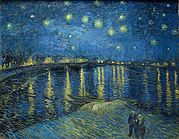 Starry Night Over the Rhone, 1888, Musée d'Orsay, Paris.
Starry Night Over the Rhone, 1888, Musée d'Orsay, Paris.
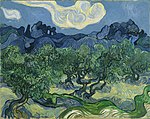 Olive Trees with the Alpilles in the Background, 1889, Museum of Modern Art, New York.
Olive Trees with the Alpilles in the Background, 1889, Museum of Modern Art, New York.
Van Gogh drew and painted with watercolors while at school, however few survive and authorship is challenged on some of those that do. When he committed to art as an adult, he began at an elementary level, copying the Cours de dessin, a drawing course edited by Charles Bargue. Within two years he had begun to seek commissions. In spring 1882, his uncle, Cornelis Marinus, owner of a well-known gallery of contemporary art in Amsterdam, asked him for drawings of the Hague. Van Gogh's work did not live up to his uncle's expectations. Marinus offered a second commission, this time specifying the subject matter in detail, but was once again disappointed with the result. Nevertheless, Van Gogh persevered. He improved the lighting of his studio by installing variable shutters and experimented with a variety of drawing materials. For more than a year he worked on single figures—highly elaborated studies in "Black and White", which at the time gained him only criticism. Today, they are recognized as his first masterpieces.


White House at Night, 1890, Hermitage Museum, St. Petersburg, painted six weeks before the artist's death
Early in 1883, he began to work on multi-figure compositions, which he based on his drawings. He had some of them photographed, but when his brother remarked that they lacked liveliness and freshness, he destroyed them and turned to oil painting. By Autumn 1882, his brother had enabled him financially to turn out his first paintings, but all the money Theo could supply was soon spent. Then, in spring 1883, Van Gogh turned to renowned Hague School artists like Weissenbruch and Blommers, and received technical support from them, as well as from painters like De Bock and Van der Weele, both second generation Hague School artists. When he moved to Nuenen after the intermezzo in Drenthe he began a number of large-sized paintings but destroyed most of them. The Potato Eaters and its companion pieces—The Old Tower on the Nuenen cemetery and The Cottage—are the only ones to have survived. Following a visit to the Rijksmuseum, Van Gogh was aware that many of his faults were due to lack of technical experience. So in November 1885 he traveled to Antwerp and later to Paris to learn and develop his skill.
After becoming familiar with Impressionist and Neo-Impressionist techniques and theories, Van Gogh went to Arles to develop on these new possibilities. But within a short time, older ideas on art and work reappeared: ideas such as working with serial imagery on related or contrasting subject matter, which would reflect on the purposes of art. As his work progressed, he painted many Self-portraits. Already in 1884 in Nuenen he had worked on a series that was to decorate the dining room of a friend in Eindhoven. Similarly in Arles, in spring 1888 he arranged his Flowering Orchards into triptychs, began a series of figures that found its end in The Roulin Family series, and finally, when Gauguin had consented to work and live in Arles side-by-side with Van Gogh, he started to work on The Décorations for the Yellow House, which was by some accounts the most ambitious effort he ever undertook. Most of his later work is involved with elaborating on or revising its fundamental settings. In the spring of 1889, he painted another, smaller group of orchards. In an April letter to Theo, he said, "I have 6 studies of Spring, two of them large orchards. There is little time because these effects are so short-lived."
Art historian Albert Boime believes that Van Gogh—even in seemingly fantastical compositions like Starry Night—based his work in reality. The White House at Night, shows a house at twilight with a prominent star surrounded by a yellow halo in the sky. Astronomers at Southwest Texas State University in San Marcos calculated that the star is Venus, which was bright in the evening sky in June 1890 when Van Gogh is believed to have painted the picture.
Self portraits
 Self-Portrait, Spring 1887, Oil on pasteboard, 42 × 33.7 cm., Art Institute of Chicago (F 345).
Self-Portrait, Spring 1887, Oil on pasteboard, 42 × 33.7 cm., Art Institute of Chicago (F 345).
 Self-Portrait, September 1889, (F 627), Oil on canvas, 65 cm × 54 cm. Musée d'Orsay, Paris.
Self-Portrait, September 1889, (F 627), Oil on canvas, 65 cm × 54 cm. Musée d'Orsay, Paris.
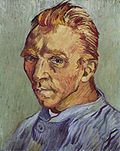 Self-portrait without beard, end September 1889, (F 525), Oil on canvas, 40 × 31 cm., Private collection. This was Van Gogh's last self portrait, given as a birthday gift to his mother.
Self-portrait without beard, end September 1889, (F 525), Oil on canvas, 40 × 31 cm., Private collection. This was Van Gogh's last self portrait, given as a birthday gift to his mother.

Van Gogh created many self-portraits during his lifetime. He was a prolific self-portraitist, who painted himself 37 times between 1886 and 1889. In all, the gaze of the painter is seldom directed at us; even when it is a fixed gaze, he appears to look elsewhere. The paintings vary in intensity and color and some portray the artist with beard, some beardless, some with bandages—depicting the episode in which he severed a portion of his ear. Self-portrait Without Beard, from late September 1889, is one of the most expensive paintings of all time, selling for $71.5 million in 1998 in New York. At the time, it was the third (or an inflation-adjusted fourth) most expensive painting ever sold. It was also Van Gogh's last self-portrait, given as a birthday gift to his mother.
All of the self-portraits painted in Saint-Rémy show the artist's head from the right, the side opposite his mutilated ear, as he painted himself reflected in his mirror. During the final weeks of his life in Auvers-sur-Oise, he produced many paintings, but no self-portraits, a period in which he returned to painting the natural world.
Portraits
 L'Arlesienne: Madame Ginoux with Books, November 1888. The Metropolitan Museum of Art, New York, New York (F488).
L'Arlesienne: Madame Ginoux with Books, November 1888. The Metropolitan Museum of Art, New York, New York (F488).
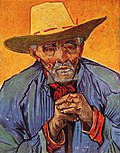 Patience Escalier, second version August 1888, Private collection (F444)
Patience Escalier, second version August 1888, Private collection (F444)
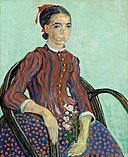 La Mousmé, 1888, National Gallery of Art, Washington D.C.
La Mousmé, 1888, National Gallery of Art, Washington D.C.
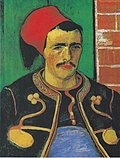 Le Zouave (half-figure), June 1888, Van Gogh Museum, Amsterdam (F423)
Le Zouave (half-figure), June 1888, Van Gogh Museum, Amsterdam (F423)
Although Van Gogh is best known for his landscapes, he seemed to find painting portraits his greatest ambition. He said of portrait studies, "The only thing in painting that excites me to the depths of my soul, and which makes me feel the infinite more than anything else."
To his sister he wrote, "I should like to paint portraits which appear after a century to people living then as apparitions. By which I mean that I do not endeavor to achieve this through photographic resemblance, but my means of our impassioned emotions—that is to say using our knowledge and our modern taste for color as a means of arriving at the expression and the intensification of the character."
Of painting portraits, Van Gogh wrote: "in a picture I want to say something comforting as music is comforting. I want to paint men and women with that something of the eternal which the halo used to symbolize, and which we seek to communicate by the actual radiance and vibration of our coloring."
Cypresses
One of Van Gogh's most popular and widely known series are his Cypresses. During the Summer of 1889, at sister Wil's request, he made several smaller versions of Wheat Field with Cypresses. These works are characterised by swirls and densely painted impasto, and produced one of his best-known paintings, The Starry Night. Other works from the series include Olive Trees with the Alpilles in the Background (1889) Cypresses (1889), Cypresses with Two Figures (1889–1890), Wheat Field with Cypresses (1889), (Van Gogh made several versions of this painting that year), Road with Cypress and Star (1890), and Starry Night Over the Rhone (1888). They have become synonymous with Van Gogh's work through their stylistic uniqueness. According to art historian Ronald Pickvance,
 Road with Cypress and Star, May 1890, Kröller-Müller Museum.
Road with Cypress and Star, May 1890, Kröller-Müller Museum.
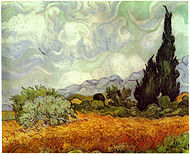 Wheat Field with Cypresses, 1889, National Gallery, London.
Wheat Field with Cypresses, 1889, National Gallery, London.
 Cypresses, 1889, Metropolitan Museum of Art, New York.
Cypresses, 1889, Metropolitan Museum of Art, New York.
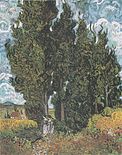 Cypresses with Two Figures, 1889–90, Kröller-Müller Museum (F620).
Cypresses with Two Figures, 1889–90, Kröller-Müller Museum (F620).
Road with Cypress and Star (1890), is compositionally as unreal and artificial as the Starry Night. Pickvance goes on to say the painting Road with Cypress and Star represents an exalted experience of reality, a conflation of North and South, what both Van Gogh and Gauguin referred to as an "abstraction". Referring to Olive Trees with the Alpilles in the Background, on or around 18 June 1889, in a letter to Theo, he wrote, "At last I have a landscape with olives and also a new study of a Starry Night."
Hoping to attain a gallery for his work, his undertook a series of paintings including Still Life: Vase with Twelve Sunflowers (1888), and Starry Night Over the Rhone (1888), all intended to form the décorations for the Yellow House.
Flowering Orchards
 Cherry Tree, 1888, Metropolitan Museum of Art, New York.
Cherry Tree, 1888, Metropolitan Museum of Art, New York.
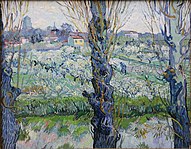 View of Arles, Flowering Orchards, 1889, Neue Pinakothek.
View of Arles, Flowering Orchards, 1889, Neue Pinakothek.
The series of Flowering Orchards, sometimes referred to as the Orchards in Blossom paintings, were among the first groups of work that Van Gogh completed after his arrival in Arles, Provence in February 1888. The 14 paintings in this group are optimistic, joyous and visually expressive of the burgeoning Springtime. They are delicately sensitive, silent, quiet and unpopulated. About The Cherry Tree Vincent wrote to Theo on 21 April 1888 and said he had 10 orchards and: one big (painting) of a cherry tree, which I've spoiled. The following spring he painted another smaller group of orchards, including View of Arles, Flowering Orchards.
Van Gogh was taken by the landscape and vegetation of the South of France, and often visited the farm gardens near Arles. Because of the vivid light supplied by the Mediterranean climate his palette significantly brightened. From his arrival, he was interested in capturing the effect of the seasons on the surrounding landscape and plant life.
Flowers
Van Gogh painted several versions of landscapes with flowers, including hisView of Arles with Irises, and paintings of flowers, including Irises, Sunflowers, lilacs and roses. Some reflect his interests in the language of color, and also in Japanese ukiyo-e woodblock prints.
 View of Arles with Irises, 1888, Van Gogh Museum, Amsterdam.
View of Arles with Irises, 1888, Van Gogh Museum, Amsterdam.
 Irises, 1889, Getty Center, Los Angeles
Irises, 1889, Getty Center, Los Angeles
He completed two series of sunflowers. The first dated from his 1887 stay in Paris, the second during his visit to Arles the following year. The Paris series shows living flowers in the ground, in the second, they are dying in vases. The 1888 paintings were created during a rare period of optimism for the artist. He intended them to decorate a bedroom where Gauguin was supposed to stay in Arles that August, when the two would create the community of artists Van Gogh had long hoped for. The flowers are rendered with thick brushstrokes (impasto) and heavy layers of paint.
In an August 1888 letter to Theo, he wrote,
"I am hard at it, painting with the enthusiasm of a Marseillais eating bouillabaisse, which won't surprise you when you know that what I'm at is the painting of some sunflowers. If I carry out this idea there will be a dozen panels. So the whole thing will be a symphony in blue and yellow. I am working at it every morning from sunrise on, for the flowers fade so quickly. I am now on the fourth picture of sunflowers. This fourth one is a bunch of 14 flowers ... it gives a singular effect." Wheat fields

 Wheatfield with Crows, 1890, Van Gogh Museum, Amsterdam See also: Wheat Fields (Van Gogh series) and The Wheat Field
Wheatfield with Crows, 1890, Van Gogh Museum, Amsterdam See also: Wheat Fields (Van Gogh series) and The Wheat Field
Van Gogh made several painting excursions during visits to the landscape around Arles. He made a number of paintings featuring harvests, wheat fields and other rural landmarks of the area, including The Old Mill (1888); a good example of a picturesque structure bordering the wheat fields beyond. It was one of seven canvases sent to Pont-Aven on 4 October 1888 as exchange of work with Paul Gauguin, Emile Bernard, Charles Laval, and others. At various times in his life, Van Gogh painted the view from his window—at The Hague, Antwerp, Paris. These works culminated in The Wheat Field series, which depicted the view he could see from his adjoining cells in the asylum at Saint-Rémy.
Writing in July 1890, Van Gogh said that he had become absorbed "in the immense plain against the hills, boundless as the sea, delicate yellow". He had become captivated by the fields in May when the wheat was young and green. The weather worsened in July, and he wrote to Theo of "vast fields of wheat under troubled skies", adding that he did not "need to go out of my way to try and express sadness and extreme loneliness". In particular, the work Wheatfield with Crows serves as a compelling and poignant expression of the artist's state of mind in his final days, a painting Hulsker discusses as being associated with "melancholy and extreme loneliness," a painting with a "somber and threatening aspect", a "doom-filled painting with threatening skies and ill-omened crows.
Legacy
Posthumous fame


Painter on the Road to Tarascon, August 1888, Vincent van Gogh on the road to Montmajour, oil on canvas, 48 × 44 cm., formerly Museum Magdeburg, believed to have been destroyed by fire in World War II
Following his first exhibitions in the late 1880s, Van Gogh's fame grew steadily among colleagues, art critics, dealers and collectors. After his death, memorial exhibitions were mounted in Brussels, Paris, The Hague and Antwerp. In the early 20th century, there were retrospectives in Paris (1901 and 1905), and Amsterdam (1905), and important group exhibitions in Cologne (1912), New York (1913) and Berlin (1914). These had a noticeable impact on later generations of artists. By the mid 20th century Van Gogh was seen as one of the greatest and most recognizable painters in history. In 2007 a group of Dutch historians compiled the "Canon of Dutch History" to be taught in schools and included Van Gogh as one of the fifty topics of the canon, alongside other national icons such as Rembrandt and De Stijl.
Together with those of Pablo Picasso, Van Gogh's works are among the world's most expensive paintings ever sold, as estimated from auctions and private sales. Those sold for over $100 million (today's equivalent) include Portrait of Dr. Gachet, Portrait of Joseph Roulin and Irises. A Wheatfield with Cypresses was sold in 1993 for $57 million, a spectacularly high price at the time, while his Self Portrait with Bandaged Ear was sold privately in the late 1990s for an estimated $80/$90 million.
Influence
In his final letter to Theo, Vincent admitted that as he did not have any children, he viewed his paintings as his progeny. Reflecting on this, the historian Simon Schama concluded that he "did have a child of course, Expressionism, and many, many heirs." Schama mentioned a wide number of artists who have adapted elements of Van Gogh's style, including Willem de Kooning, Howard Hodgkin and Jackson Pollock. The Fauves extended both his use of color and freedom in application, as did German Expressionists of the Die Brücke group, and as other early modernists. Abstract Expressionism of the 1940s and 1950s is seen as in part inspired from Van Gogh's broad, gestural brush strokes. In the words of art critic Sue Hubbard: "At the beginning of the twentieth century Van Gogh gave the Expressionists a new painterly language that enabled them to go beyond surface appearance and penetrate deeper essential truths. It is no coincidence that at this very moment Freud was also mining the depths of that essentially modern domain—the subconscious. This beautiful and intelligent exhibition places Van Gogh where he firmly belongs; as the trailblazer of modern art."
In 1957, Francis Bacon (1909–1992) based a series of paintings on reproductions of Van Gogh's The Painter on the Road to Tarascon, the original of which was destroyed during World War II. Bacon was inspired by not only an image he described as "haunting", but also Van Gogh himself, whom Bacon regarded as an alienated outsider, a position which resonated with Bacon. The Irish artist further identified with Van Gogh's theories of art and quoted lines written in a letter to Theo, "[R]eal painters do not paint things as they are...They paint them as they themselves feel them to be". An exhibition devoted to Vincent van Gogh's letters took place in the Van Gogh Museum in Amsterdam from October 2009 to January 2010 and then moved to the Royal Academy in London from late January to April.
Source: wikipedia.org, news.lv
No places

| Relation name | Relation type | Description | ||
|---|---|---|---|---|
| 1 |  | Paul Gauguin | Familiar | |
| 2 |  | Henri de Toulouse-Lautrec | Idea mate |
02.06.1873 | W Amsterdamie otwarto Muzeum Vincenta van Gogha
Muzeum van Gogha (ang. The Van Gogh Museum) to muzeum w Amsterdamie (Holandia) poświęcone sztuce Vincenta van Gogha i czasom, w których żył. Aktualnie znajduje się tam ponad 200 obrazów mistrza, 500 jego rysunków i 700 listów; jest to największa taka kolekcja na świecie.
04.08.1919 | Parīzē atvērts Ogista Rodēna muzejs
Rodēna muzejs (fr Musée Rodin.) - Mākslas muzejs Francijā, kurā atrodas lielākā Ogista Rodēna darbu kolekcija. Tas atvērts 1919. gadā. Muzejs atrodas Bīronu pilī Parīzē, Rue de Varenne 7. kvartālā. Pils celta 1727.-1732. gadam. Kopš 1904. gada ēkā izmitināti dažādi mākslinieki, tai skaitā O. Rodēns (1908.-1917. gadam). Pateicoties viņa ietekmei, pils tika paglābta no nojaukšanas, un 1916. gadā tika nolemts savākt šeit Rodēna darbus, un saistīti ar viņa dzīves un darba dokumentiem. Muzejā ir vairāk nekā 6600 skulptūras, 8000 fotogrāfijas un 7000 citi mākslas darbi.
15.04.1935 | Signet Roerich Pact
15.05.1990 | Portret doktora Gacheta Vincenta van Gogha został sprzedany za 82,5 mln dolarów
15 maja 1990 rodzina Kramarsky'ego wystawiła obraz na sprzedaż w nowojorskim oddziale domu aukcyjnego Christie's. Tam zainteresował się nim japoński kolekcjoner Ryoei Saito i zakupił go płacąc 82,5 mln dolarów, co było wówczas światowym rekordem w handlu dziełami sztuki. Saito wkrótce wywołał skandal ogłaszając, iż chciałby, aby po jego śmierci obraz spalono. Zmarł on w 1996 i od tamtej chwili dalsze losy obrazu nie są znane.







